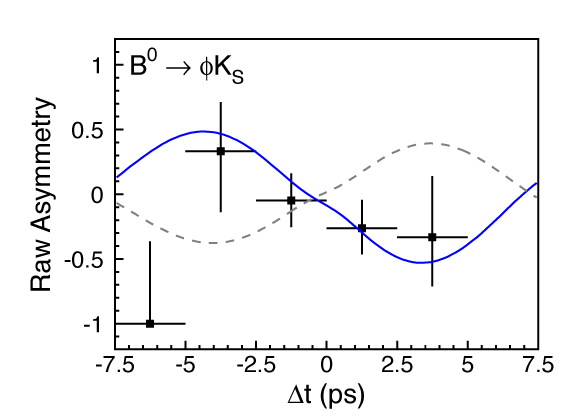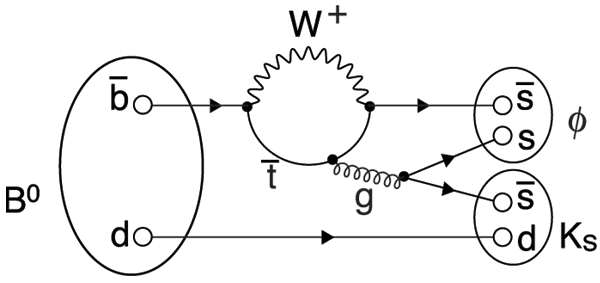|
The High Energy Accelerator Research Organization (KEK) announced that the Belle collaboration, an international research team working at the KEKB accelerator, found evidence for a new phenomenon that cannot be explained by the Standard Model of elementary particles.
The KEKB accelerator is a device for generating a large number of very shortlived subatomic particles called B mesons as well as their anti-matter counterparts. These particles, each with a mass somewhat greater than that of the helium atom, disintegrate after about a few trillionths of a second into lighter and more long-lived daughters, and these decay products are detected by the Belle detector.
Studies of these B meson decays play a crucial role in our understanding of the behavior of matter at its most elementary level, notably in investigating the origin of the tiny difference that is known to exist between matter and anti-matter, called CP violation.
The first clear evidence that such CP violation occurs in B meson decays was reported two years ago by the Belle and the BaBar collaborations, the latter working at the Stanford Linear Accelerator Center in California. Since then, the Belle team has been expanding the scope of its investigation into the ways that CP violation might manifest itself. A new and surprising finding has arisen recently in the course of this work.
In one particular and infrequent process, the B meson (or its anti-matter counterpart) decays into exactly two daughters named the J/y meson and the KS meson, and the size of the CP violation is characterized by a quantity called sin2f1. (This quantity would be zero if there were no CP violation, but could be as strong as ±1 according to the Standard Model.) This quantity is now known to be 0.731 with an accuracy of ± 0.056, and is in excellent agreement with what can be inferred indirectly from a host of other data with the assumption of one single source of CP violation as envisioned by M. Kobayashi and T. Maskawa in 1973.
If the Standard Model is correct, several other rarer B meson decay processes will show CP violation of a size that is determined by this same sin2f1.
Using the entire data sample of 150 million pairs of B and anti-B mesons recorded over the past four years, the Belle team found 68 cases of an alternate CP-sensitive process where the B meson decays into a f meson plus a KS meson. Surprisingly, the measurement of sin2f1 in this process gave -0.96±0.50, in contrast to the well established value of +0.731 ± 0.056.
The observed asymmetry data, from which the value of sin2f1 is determined, is shown in Figure 1. The observed asymmetry data shown by the dots (with vertical lines) are clearly different from what is expected by the Standard Model, whose prediction is indicated by the smooth dotted curve. The probability of obtaining the observed value of -0.96 ± 0.50 as a statistical fluctuation from the value of +0.731 ± 0.056 is less than 0.1%.
The B -> f + KS decay is known to occur through a process involving so-called "quantum fluctuations" where the beauty quark within the B meson splits, for a brief instant, into a top quark and a W boson.(see Figure 2) It is possible, although not incorporated in the Standard Model, that the top quark and/or W boson in this quantum fluctuation could be replaced occasionally by new particles that have been postulated but never seen. Their hidden presence here might appear as the anomalous value for sin2f1 now observed by the Belle group for this decay mode.
The Standard Model has enjoyed overwhelming success since it was conceived roughly 30 years ago. Although it is too soon to draw firm conclusions, Belle's new observation may impose a serious challenge to this theory if it is confirmed when additional data are acquired. Even as it now stands, it is the most serious discrepancy with the Standard Model, and may, for example, be hinting at the existence of supersymmetric particles or something even more exotic. Detailed investigations of this phenomenon and related processes with larger B meson samples are now a top priority in high energy physics.
|




